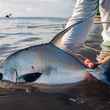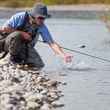While I'm a fairly dedicated winter angler the past few weeks made it difficult to get excited about hitting the water. The thermometer has stuck close to the single digits lately and I don't recall the last time it was above freezing. Most rivers and streams are locked solid and even the tailwaters are struggling to run free. If I wanted this sort of weather I'd live up in some mountain valley in Colorado. Sitting in western Connecticut it shouldn't feel like the Rockies but it does. Except without the mountains and the legal pot.
While I consider my glass half empty situation I scan the news sites which, given my mood, only serves to destroy hope. From West Virginia to Montana industry seems hidebound to poison our waters. Another oil pipeline has burst, this one full of Canadian oil, fouling the Yellowstone River and drinking water in a season that foils clean-up efforts. Bakken oil filled tanker cars have finished exploding but not burning along the banks of the befouled Kanawha River. It seems there's no reliably safe way to transport the stuff.






























